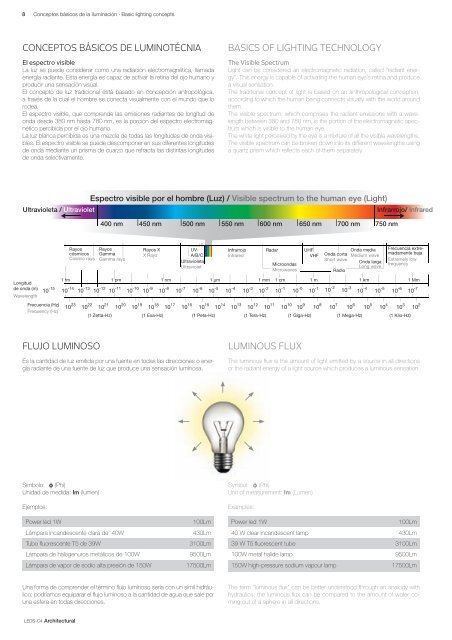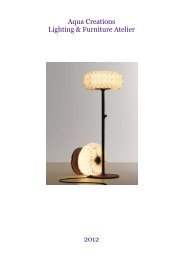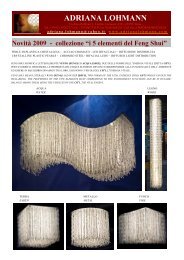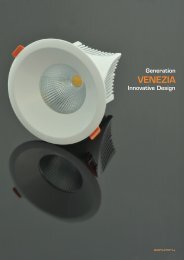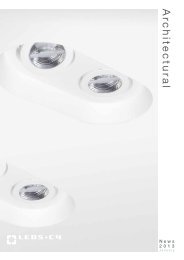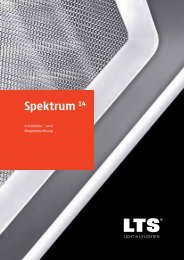Architectural - Profi Lighting
Architectural - Profi Lighting
Architectural - Profi Lighting
- No tags were found...
Create successful ePaper yourself
Turn your PDF publications into a flip-book with our unique Google optimized e-Paper software.
8 Conceptos básicos de la iluminación · Basic lighting conceptsCONCEPTOS BÁSICOS DE LUMINOTÉCNIAEl espectro visibleLa luz se puede considerar como una radiación electromagnética, llamadaenergía radiante. Esta energía es capaz de activar la retina del ojo humano yproducir una sensación visual.El concepto de luz tradicional está basado en concepción antropológica,a través de la cual el hombre se conecta visualmente con el mundo que lorodea.El espectro visible, que comprende las emisiones radiantes de longitud deonda desde 380 nm hasta 780 nm, es la porción del espectro electromagnéticopercibida por el ojo humano.La luz blanca percibida es una mezcla de todas las longitudes de onda visibles.El espectro visible se puede descomponer en sus diferentes longitudesde onda mediante un prisma de cuarzo que refracta las distintas longitudesde onda selectivamente.BASICS OF LIGHTING TECHNOLOGYThe Visible SpectrumLight can be considered an electromagnetic radiation, called “radiant energy”.This energy is capable of activating the human eye’s retina and producea visual sensation.The traditional concept of light is based on an anthropological conception,according to which the human being connects visually with the world aroundthem.The visible spectrum, which comprises the radiant emissions with a wavelengthbetween 380 and 780 nm, is the portion of the electromagnetic spectrumwhich is visible to the human eye.The white light perceived by the eye is a mixture of all the visible wavelengths.The visible spectrum can be broken down into its different wavelengths usinga quartz prism which refl ects each of them separately.Espectro visible por el hombre (Luz) / Visible spectrum to the human eye (Light)Ultravioleta / UltravioletInfrarrojo/ Infrared400 nm450 nm 500 nm 550 nm 600 nm 650 nm 700 nm 750 nmRayoscósmicosCosmic raysRayosGammaGamma raysRayos XX RaysUV-A/B/CUltravioletaUltravioletInfrarrojoInfraredRadarMicroondasMicrowavesUHFVHFOnda cortaShort waveRadioOnda mediaMedium waveOnda largaLong waveFrecuencia extremadamentebajaExtremely lowfrequencyLongitudde onda (m)WavelengthFrecuencia (Hz)Frequency (Hz)1 fm 1 pm 1 nm 1 μm1 mm 1 cm 1 m 1 km 1 Mm10 -15 10 -14 10 -13 10 -12 10 -11 10 -10 10 -9 10 -8 10 -7 10 -6 10 -5 10 -4 10 -3 10 -2 10 -1 10 -0 10 -1 10 -2 10 -3 10 -4 10 -5 10 -6 10 -710 23 10 22 10 21 10 20 10 19 10 18 10 17 10 16 10 15 10 14 10 13 10 12 10 11 10 10 10 9 10 8 10 7 10 6 10 5 10 4 10 3 10 2(1 Zetta-Hz)(1 Exa-Hz) (1 Peta-Hz) (1 Tera-Hz) (1 Giga-Hz) (1 Mega-Hz) (1 Kilo-Hz)FLUJO LUMINOSOEs la cantidad de luz emitida por una fuente en todas las direcciones o energíaradiante de una fuente de luz que produce una sensación luminosa.LUMINOUS FLUXThe luminous fl ux is the amount of light emitted by a source in all directionsor the radiant energy of a light source which produces a luminous sensation.Símbolo: ф (Phi)Unidad de medida: lm (lumen)Ejemplos:Symbol: ф (Phi)Unit of measurement: lm (Lumen)Examples:Power led 1WLámpara incandescente clara de 40WTubo fl uorescente T5 de 39WLámpara de halogenuros metálicos de 100WLámpara de vapor de sodio alta presión de 150W100Lm430Lm3100Lm9500Lm17500LmPower led 1W100Lm40 W clear incandescent lamp 430Lm39 W T5 fl uorescent tube 3100Lm100W metal halide lamp9500Lm150W high-pressure sodium vapour lamp17500LmUna forma de comprender el término fl ujo luminoso sería con un símil hidráulico;podríamos equiparar el fl ujo luminoso a la cantidad de agua que sale poruna esfera en todas direcciones.The term “luminous fl ux” can be better understood through an analogy withhydraulics: the luminous fl ux can be compared to the amount of water comingout of a sphere in all directions.LEDS-C4 <strong>Architectural</strong>


